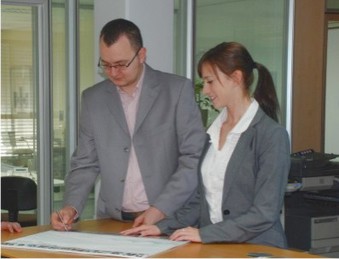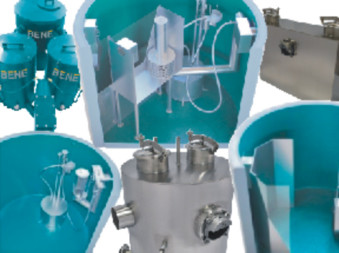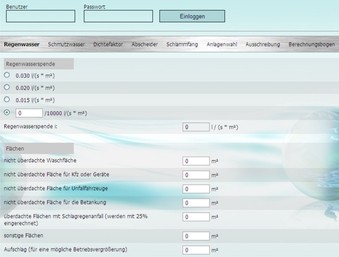BENE - competent, personal support. We look forward to hearing from you.
Technical lexicon
- Separator
The separation process ensures the separation of material mixtures (e.g., light fluids). In the ideal case, the goal of the separation process is the complete isolation of individual material mixture components. A separator is the corresponding wastewater treatment system in which this process takes place. - Accumulating materials
Materials that accumulate on the base after they separate from the surrounding medium after a defined period due to their density properties, etc. - Wastewater
Household water organization act (Wasserhaushaltsgesetz – WHG)
Section 54 Specification of definitions for wastewater removal (1) Wastewater is
1. water that is changed due to household, commercial, agricultural or other use in terms of its qualities and which collects with draining water during dry weather (fouled water) and
2. precipitation that collects with draining water from the areas of buildings or reinforced surfaces (precipitation water).
Fouled water also includes fluids that exit and collect from systems for the treatment, storage, and removal of waste. - Wastewater treatment
The removal of materials contained in wastewater and the recovery of the naturally occurring water quality are the objectives of wastewater treatment. According to Section 57 WHG, wastewater must be treated according to the state of the art before direct introduction (introduction to bodies of water). The minimum requirements for introduction from specific source areas are specified in the wastewater directive. Section 58 WHG regulates indirect introduction (introduction of wastewater into public wastewater systems).
Wastewater includes all processes for benign drainage, purification, recycling and recovery of reusable materials in order to reduce resulting wastewater. - Wastewater removal
Household water organization act (Wasserhaushaltsgesetz – WHG)
Section 54 Specification of definitions for wastewater removal
(2) Wastewater removal includes the collection, conveyance, treatment, introduction, leaching, raining, and dripping of wastewater from treatment sludge in connection with wastewater removal. Wastewater removal also includes the removal of sludge resulting in small-scale wastewater treatment plants. - Wastewater directive (AbwV)
Directive concerning requirements for the introduction of wastewater to bodies of water. - Adsorption
Adsorption refers to the accumulation of materials from fluids or gases on a solid surface. - Active charcoal
Active charcoal is a fine-grain, porous carbon material with a large internal surface that may be used as an adsorption material for water and wastewater treatment. - General construction supervision approval
For construction products and construction designs for which there are no generally acknowledged regulations or which deviate significantly from these, general construction supervision approvals (abZ) are awarded. These are considered to be judgements concerning the usability or application of the object of the approval with regard to construction supervision requirements. General construction supervision approvals are awarded by the German Institute for Building Technology (DIBt). - Buoyancy control
Device/procedure that is used to prevent the separator container from being pushed up out of the ground in spite of its very large deadweight. This is possible when the ground water is so high that the separator container could possibly be displaced in it, and the resulting buoyancy is greater than the deadweight/coating friction and the load of the ground present above the container. - Design precipitation
Parameter for calculation of accumulating rainwater quantities. - Process water
Process water, often referred to as consumable water or industrial water, is a water category that serves a specific technical, commercial, or industrial application. Different than drinking water, process water is not intended for drinking, cooking, etc. Nevertheless, it must correspond with certain minimum hygiene standards. In any case, it must meet the technological requirements of the respective application process. - Biodiesel
See FAME. - CE label
Directive(EC) No. 765/2008 of the European Parliament and the Council
Chapter I – General specifications
Article 2 – Term specifications
20. "CE label": Label with which the manufacturer declares that the product meets the requirements that are specified in the legal harmonisation regulations of the community concerning its attachment. - German Institute for Construction Technology (Deutsches Institut für Bautechnik - DIBt)
The German Institute for Construction Technology (DIBt) is the national approval agency for non-regulated construction products and designs. The DIBt assumes its function as a service centre for a variety of tasks in the areas of building technology and supervision, including the issuance of general construction supervision approvals - Density
The density or mass density is the quotient of the mass and the volume of a body. - DIN
The Deutsches Institut für Normung e. V. (DIN) is the most important standards organisation in Germany. The standards from this organisation are called DIN standards. As a registered association, the Deutsche Institut für Normung operates as a private commercial organisation.
The most important national standards for the separator industry are DIN 1999-100 + DIN 1999-101 (separator systems for light fluids) and DIN 4040-100 (separator systems for grease). - Direct introducer
Companies that introduce their wastewater directly into bodies of water via the sewer system. According to the household water act, water-related legal permission is required for this. - Emulsions
Emulsions are a finely distributed mixture of two fluids that normally cannot be mixed, e.g., a mineral light fluid and water. - Technical qualification
DIN 1999-100 separator systems for light fluids
14.6 Examination (general inspection)
2) Technically qualified personnel include employees of operator-independent operations, expert appraisers, or other institutions, who possess proof of the required technical knowledge for the operation, maintenance, and inspection of separator systems in the scope indicated here and the technical equipment for inspecting separator systems. In individual cases, these inspections may also be completed for larger operating units by internally independent, technically qualified personnel of the operator, who are not bound by instructions according to their area of activity, and who possess the same qualifications and technical equipment. - FAME
Fatty acid methyl ester, also referred to as biodiesel, is a diesel fuel that is gained from vegetable materials. The chemical composition differs significantly between biodiesel and diesel fuel in terms of their mineral origin, but they certainly possess the same combustion properties in motors. - Grease separator
Grease separators are systems for separating greases and oils from wastewater. Wastewater containing grease and oils from industrial kitchens, restaurants, meat and fish processing operations, etc., must be cleaned by a grease separator before introduction to the sewer system. - Filtration
Filtration, also referred to as filtering, is a process for purification or separation. This involves a mechanical process. - Disaster
In the area of separator systems, a disaster is understood as an operational interruption that is connected with leaking water-hazardous materials. - Lifting system
Shafts with an integrated pumping system for pumping rain and fouled water into a pressurised line. - Indirect introducer
A wastewater producer that introduces its wastewater into a body of water via the sewer system and therefore "indirectly" via the municipal wastewater treatment plant. - Coalescence
In general, coalescence refers to the confluence of finely distributed particles, e.g., emulsion droplets. For this to occur, these particles must collide and fuse. The surface of the resulting droplet is then less than the sum of all surfaces of the individual droplets. The diminished surface reduces the friction coefficient so that the droplet either floats or sinks as a result. - KOSTRA data
KOSTRA-DWD-2000 is a severe precipitation catalogue that is published by the German weather service (DWD). The abbreviation stands for 'coordinated severe precipitation regional evaluation'. For measurement/calculation of water management systems, the probability of the occurrence of severe precipitation events is required. For this reason, DWD has published extensive evaluations of historical precipitation events and statistical calculations in the catalogue mentioned above. - State water legislation
The state water legislation (Landeswassergesetze) refers to laws of individual German states that affect bodies of water (e.g., protection, usage, disposal). They complete and specify legal water-related instructions of the country. The household water act (Wasserhaushaltsgesetz - WHG) represents a complete set of regulations on behalf of the country. This limits the individual states from competing through legislation, i.e., state water legislation (Landeswassergesetze - LWG). The states may only specify partial deviations from the WHG and use the opening clauses of the same. - LAU systems
Systems for storing, filling, and transferring water-hazardous materials. - Monolithic
Monolithic refers to all components that are cast as a single piece. - RiStWag
The guidelines for technical construction procedures involving streets in water protection areas (RiStWag) must be observed in Germany during all construction activities in the corresponding areas. - Fouled water
In the area of separator systems, fouled water is considered commercial or industrial wastewater, i.e., wastewater from companies that is introduced into the public sewer system. - Sedimentation
Sedimentation refers to the accumulation or compaction of particles consisting of gases or fluids due to the influence of gravity, etc. - Camber
Camber refers to the dimensions of a separator and indicates the top edge of coverage (ground surface). This must be arranged high enough vis-a-vis the standard level of the surface to be drained. - Ü symbol
The Ü symbol (Übereinstimmungszeichen der Länder) on construction products confirms that the same corresponds with the relevant technical regulations, a general construction supervision approval has been issued, the same corresponds with the construction supervision testing certificate, or that approval has been awarded in individual cases. Currently, the national Ü symbol has essentially been replaced by the European CE label. - VAwS
The directive pertaining to systems handling water-hazardous materials (Verordnung über Anlagen Umgang mit wassergefährdenden Stoffen - VAwS) is a legal directive that is provided for the protection of water against hazardous materials. - Leaching
In water technology, leaching is understood as the introduction of precipitation water (rain water, etc.) into the underground region via technical leaching systems. - Drainage capability
In hydrology, drainage capabilities of all types refer to all types of channels (e.g., bodies of water and ground drainage), in which water is able to drain into a body of water in the form of wastewater, drainage water, or rainwater. A natural drainage capability refers to an openly flowing body of water that accepts and deviates water from other bodies of water, groundwater bodies, or drain systems. - Water-endangering fluids
Materials that are rated as water-endangering fluids according to a list provided by the German ministry for the environment, protection of nature, building and reactor safety (Bundesministerium für Umwelt, Naturschutz, Bau und Reaktorsicherheit - BMUB).. - Household water act (Wasserhaushaltsgesetz)
The main part of German water legislation is formed by the household water act (Wasserhaushaltsgesetz - WHG). This includes regulations concerning the protection and use of groundwater and surface bodies of water, as well as legislation regarding the expansion of bodies of water, water management planning, and flood protection. - Water protection area
In water protection areas (Wasserschutzgebiet - WSG), special systems must be provided to protect bodies of water (i.e., groundwater, above-ground bodies of water) against damaging influences.





